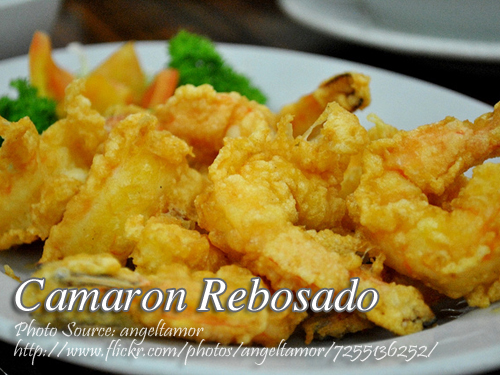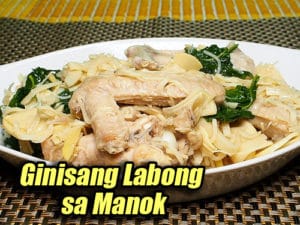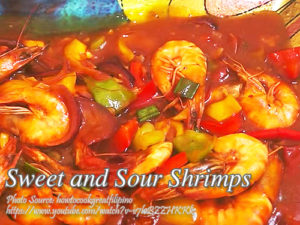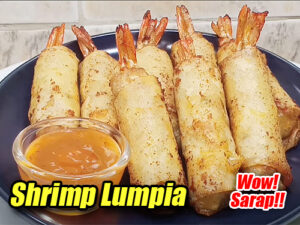Camaron rebosado or simply known as battered fried shrimps is a tasty appetizer or viand. This shrimp dish is a Filipino version of tempura which is a Japanese dish. Preparation is very simple, you only need to make a batter and hand dip each shrimp in the batter then fry it until golden brown.
When cooking shrimps, you will notice that the shrimps curl up. The technique for the shrimp to stay straight is by making a crosswise slit in the inner side of the shrimp. Of course a small piece of bamboo stick will work too by skewing so the shrimp will not curl. Just don’t for get to remove it after cooking.
Camaron Rebosado: A Nostalgic Taste of Home
I still remember the first time I made dish with my family. It was a Sunday afternoon at my Lola’s house in Cavite, and the kitchen was buzzing with laughter, chatter, and the sizzling sound of deep-frying shrimp. My Tita Nena, who had always been the family cook, guided me step by step, sharing tips she learned from her mother. “The secret,” she said, as she gently dipped each shrimp into the batter, “is in making the shrimp stay perfectly straight.” I didn’t think much of it then, but now every time I make this dish, I remember her wisdom, and it brings back that warmth of cooking together.
What is Camaron Rebosado?
The dish is a beloved Filipino dish that many of us have grown up enjoying during family gatherings or fiestas. Essentially, it’s battered fried shrimp, similar to Japanese tempura, but with its own unique Filipino twist. This dish can be served as an appetizer or a main course, often paired with a tangy sweet and sour sauce to balance the crispy, savory shrimp.
I learned from my Uncle Lito that this dish actually finds its roots in the Spanish colonization of the Philippines. The Spanish brought many culinary influences to our shores, and over time, we adapted and made these dishes our own. That’s how it evolved — a simple, comforting dish that always manages to impress, whether served on a regular day or a special occasion.
The Key to Perfectly Fried Shrimp
One thing that always puzzled me when I first tried making the shrimp dish was how to keep the shrimp from curling up when frying. My Tita Nena had a simple yet genius technique. “Make a small crosswise slit along the inside of the shrimp,” she told me. This prevents the shrimp from curling too much while frying, allowing them to stay nice and straight, giving you that professional look. It’s a small detail, but it makes a big difference when you’re trying to get that crispy, golden brown exterior just right.
Another trick she shared was using a bamboo stick to skewer the shrimp before frying. This method guarantees that the shrimp won’t curl, but be sure to remove the stick right after cooking. The end result is shrimp that not only taste great but also look perfect on the plate.
The Perfect Batter: Light, Crisp, and Golden
The batter for battered shrimp is a simple yet essential component of this dish. It’s all about creating a light and crispy coating that complements the shrimp without overpowering it. When I was younger, I’d often wonder why my shrimp wasn’t as crispy as Tita Nena’s. After a few tries, I realized it was all about the right balance of ingredients.
The mixture of flour, cornstarch, and water, folded into well-beaten eggs, creates a batter that’s both crisp and light. The cornstarch, in particular, is key. It helps the batter stick to the shrimp and fry to a beautiful golden brown without becoming too heavy. My cousin Eric, who recently visited from Davao, even suggested adding a pinch of baking powder for an extra crispy finish, and it worked like a charm!
Cooking with Family Memories
Whenever I make this dish, I can’t help but be transported back to those family cooking sessions. My younger brother, Jomar, would always try to sneak a shrimp right after frying, burning his fingers in the process because he couldn’t wait for them to cool down! It’s these little memories that make cooking it more than just preparing a meal. It’s about preserving family traditions, sharing stories, and passing down techniques from one generation to the next.
Now, whenever I make this dish for my own family, I find myself echoing the same tips that Tita Nena and Uncle Lito gave me. And every time, I’m reminded that it is not just a dish—it’s a connection to the past, and to the people who shared their love of food with me.
Sweet and Sour Sauce: The Perfect Companion
Of course, no camaron rebosado is complete without a dipping sauce, and my personal favorite is the classic sweet and sour sauce. The tanginess of the sauce perfectly cuts through the richness of the fried shrimp, creating a well-balanced bite every time. I remember my older sister, Anita, whipping up a quick homemade version when we were short on ingredients. It was just vinegar, sugar, ketchup, and a touch of soy sauce, but it paired beautifully with the crispy shrimp.
A Dish Worth Sharing
There’s something truly special about sharing a plate of camaron rebosado with loved ones. Whether it’s for a small family lunch or a big celebration, this dish has a way of bringing people together. The simplicity of the ingredients, combined with the nostalgic memories it evokes, makes it a staple in many Filipino households.
For those trying it for the first time, don’t worry if your shrimp curls up or your batter isn’t as crispy as you’d like. Cooking, like many of our cherished family recipes, is a learning process. With a little practice, you’ll soon be able to master the art of cooking it, just like Tita Nena did, and pass it on to the next generation.
How to Cook Camaron Rebosado
Ingredients
- 1/2 kilo shrimps shelled with tail left
- 1 Tbsp. lemon juice
- 1/2 cup all-purpose flour
- 1/2 cup cornstarch
- 1 pc egg well beaten
- 1/8 tsp. ground black pepper
- 1/2 tsp. salt
- 3 cups cooking oil for deep frying
Instructions
How to Cook Camaron Rebosado:
- Clean the shrimps by peeling shell and removing the head. Leave the tail.
- Devein the shrimps by making a slit at the back and removing the vein.
- Marinate the shrimp in lemon juice for 15 minutes.
- Fold in flour, cornstarch, water, black pepper and salt in well beaten eggs.
- Dip each shrimp (excluding the tail) into prepared batter and deep fry until golden brown.
- Serve with sweet and sour sauce.
Video
Notes
Cooking Tips:
Keep Your Shrimp Straight
To prevent the shrimp from curling while frying, make a small crosswise slit along the inner side of the shrimp. This technique helps the shrimp stay straight, giving them a better appearance and even cooking. You can also skewer the shrimp with a bamboo stick and remove it after frying for a perfect presentation.Achieve the Perfect Batter Consistency
The key to a light and crispy coating is ensuring the batter isn't too thick. Combine flour, cornstarch, and water with well-beaten eggs until smooth but slightly runny. A thin batter will adhere to the shrimp better and fry up crisp without becoming heavy or soggy.Fry in Small Batches
To get that golden, crunchy crust, avoid overcrowding the pan when frying the shrimp. Frying in small batches ensures that the oil temperature remains consistent, allowing the shrimp to cook evenly and crisp up nicely. Overcrowding can lower the oil temperature and result in a greasy, uneven coating.





